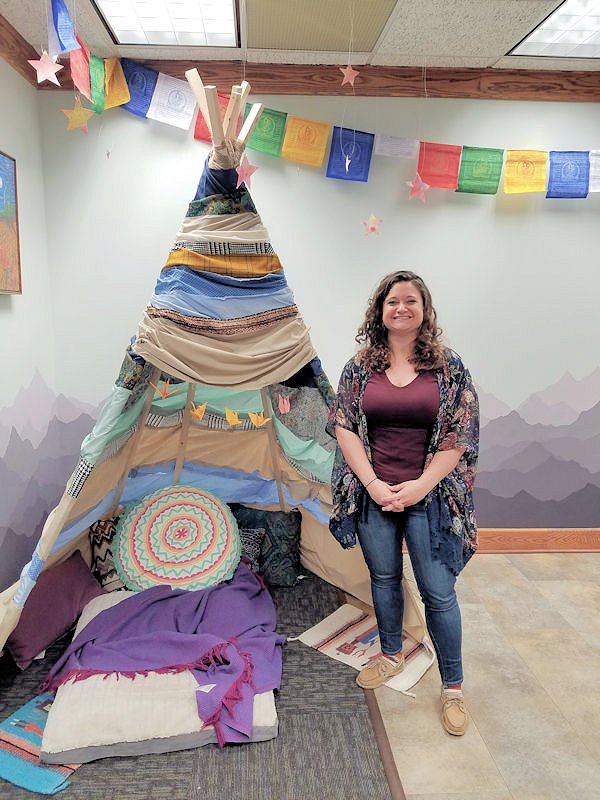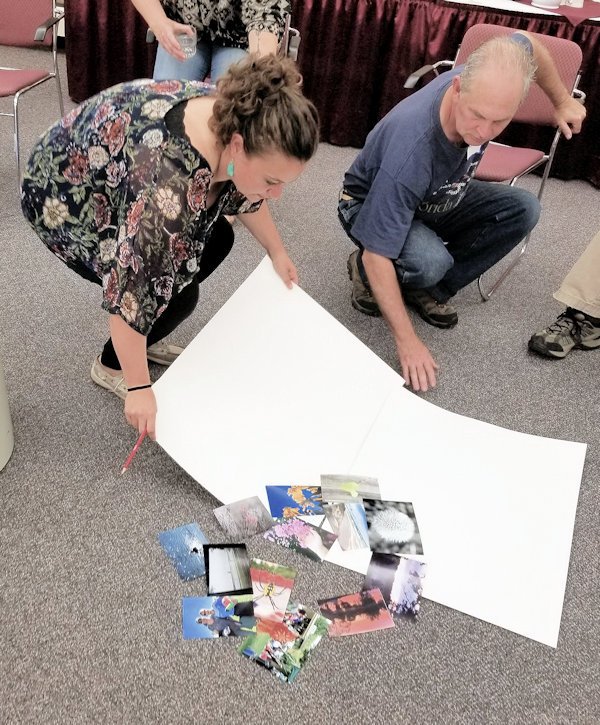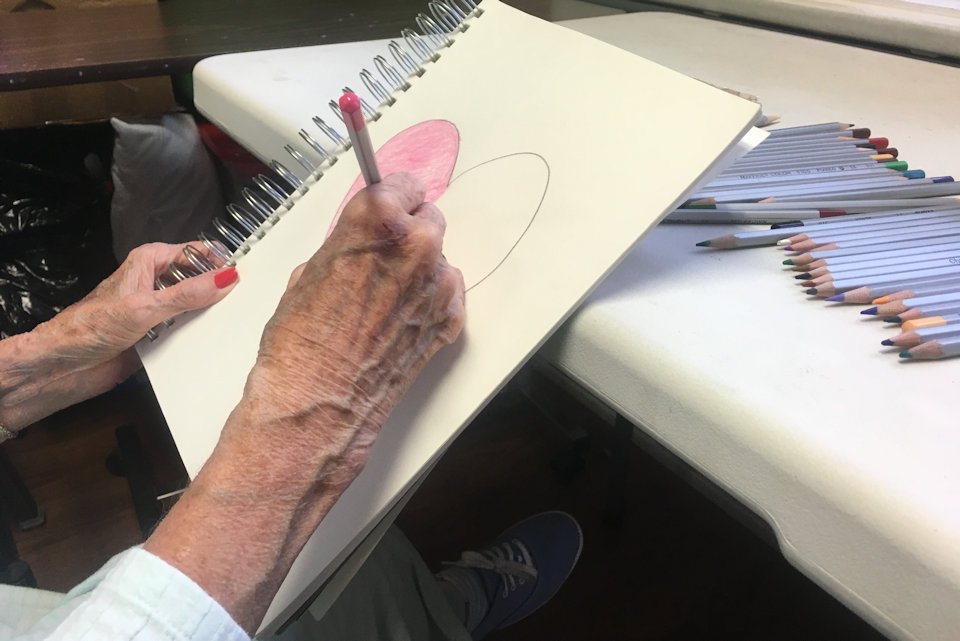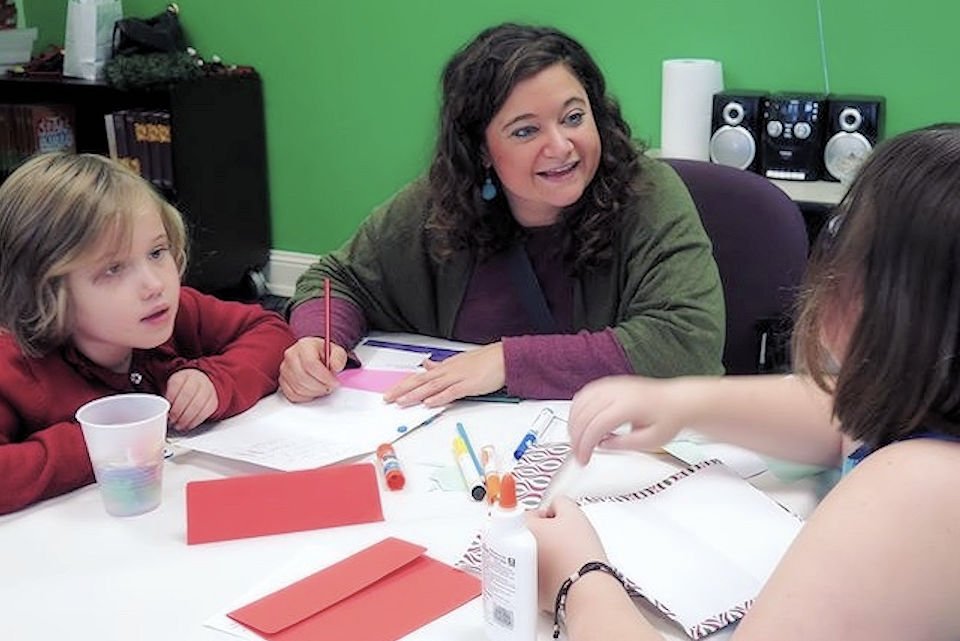An Art Therapy studio, hosted by Leara Glinzak, is an extension of the ministry of Grand Rapids: First United Methodist Church. “My goal,” she says, “is to get people inspired and curious.”
KAY DEMOSS
Senior Content Editor, Michigan Conference
What was it about the recent burning of Notre Dame Cathedral that touched the soul of millions around the world? Many would answer it was the loss of the work of artists and artisans, some named and many nameless; the destruction of architecture, sculpture, paintings, mosaics and stained glass that taught and inspired the faithful since the 12th century. Notre Dame’s art is what makes the cathedral a significant part of the soul of western civilization.
Leara Glinzak might also suggest that such loss of the world’s great art touches and calls forth the artist in all of us. Leara is a Registered Art Therapist who has a studio at First Place, across the street from Grand Rapids: First United Methodist Church.

A year ago, Leara “received my key” from First UMC. The key opened a storeroom packed full of stuff. By August of 2018, Leara had transformed the room into an art therapy studio called, “I LIGHT.” “I see my work as a ministry that nurtures spiritual growth,” she says. “The studio is healing and therapeutic space as well as a creative space.” Read more of Leara’s bio here.
The Rev. Tim Tuthill, Associate Pastor and Director of Congregational Care for Grand Rapids: First UMC, says of the invitation to Leara to join the ministry orbit of First UMC. “Art therapy brings a complimentary and holistic approach to the work we are looking to do in our church and neighborhood.”
In 2014 Tim was on the staff of Clark Retirement community. Leara learned that he was looking for an art therapist to engage seniors there. She joined the Clark staff and for the next two years worked in life enrichment and dementia care.
After leaving Clark, Leara wasn’t sure what was next on her life path but knew, “I went into the field of art therapy to serve others.” She researched opportunities to express her desire to serve. She did a free workshop for the Dominican Center in Grand Rapids where she then joined the presenter’s team and she presented to and other organizations around the country on topics like cancer care, addiction, aging, trauma and grief. Leara occasionally did joint presentations with Tim Tuthill. Tim recalls, “When I heard Leara was making a career move, I immediately started talking with her.” She was introduced to Senior Pastor, Bob Hundley, and her relationships with First UMC began.
Back to the empty room at First Place Leara entered 13 months ago. “I tried to be very intentional with this space,” Leara says. “When I think of someone who comes to the studio for the first time I imagine sometimes people’s hearts are racing there may be feelings of nervousness or anxiety as well with coming here.” Once the room was emptied of stored stuff, Leara was very intentional in creating an environment filled with meaning.
Leara herself finds nature resonates with themes of healing. So, she brought nature into the studio space because, “we don’t have a lot of nature in this downtown area.” She painted shades-of-purple mountains on the studio walls.
“When I think of the imagery of a heartbeat and a pulse I think it looks like mountains, and I realized I needed to bring the pulse of the Earth into this space. There are tear-drop shaped air-plant vases, plant holders that look like hail stones, and shelves on the wall that are made of half-rounds of a tree she cut down herself.

Who uses the studio and what happens within its walls? The studio is open to any and all who come. The studio is safe space for neighbor or church member. Leara remarks that some arrive feeling, “Nowhere else is open,” and adds, “they need a sanctuary.” She invites people to “come as you are to a place where we help each other” and likens that to the mission of the church at its best. “Mark-making [art] is similar to meaning-making,” she notes. “we are not here making the Mona Lisa but what we make has its own meaning and enables us to better understand the hard situations of life.”
Persons from community organizations — like Families Against Narcotics Grand Rapids, Sanford House, Pine Rest, and Parkinson’s support groups– come to the studio for Leara’s guidance. Individual sessions are held at First Place for those struggling with PTSD, distress, grief, anxiety or depression. There’s Open Studio twice a month for any who enter through the doors needing creative, relaxing and inspiring space. Post graduate students also work under Leara for their supervision hours through the I Light studio. During Open Studio people engage in an art directive using available materials or materials they bring with them. “The goal,” Leara says, “is to get people to feel comfortable, inspired and curious.” She hosts Soul-fill Sundays art therapy and yoga each month that foster the practice of mindfulness. Something new, a Sound Bath Workshop, is coming in May.
Leara notes that she “keeps an eye open for where there is a need,” then she explores how to meet the need. Some of her ministry serves the congregation across the street at First UMC. She has led Art in Advent and Art in Lent sessions that explore spiritual themes and art history. Leara also works with the Stephen Ministers of FUMC.
The American Art Therapy Association formally defines art therapy this way: “Art therapy is an integrative mental health and human services profession that enriches the lives of individuals, families, and communities through active art-making, creative process, applied psychological theory, and human experience within a psychotherapeutic relationship.” The text book definition goes on to say that through the skills of a professional art therapist, the fruits of art therapy include enhanced thought processes, sensorimotor skills, self-esteem, self-awareness, emotional resilience, social skills, and reduced stress.
In other words, art therapy can be life changing. Again, that sounds like the mission of the church. In faith and in art, it’s not about perfection but discovery of “a bigger plan for us.” In artistic expression, according to Leara, “We surrender to the process in the same way that we surrender to the divine.”
“In art therapy we have a phrase, ‘trusting the process,’” Leara says. “When I hear that phrase, I think of a leap of faith.” Art therapy goes beyond someone simply making something. The registered art therapist utilizes a creative process, in a series of experiences, that helps an individual find his or her own meaning and live a more fulfilling life. An art therapist does not interpret for the individual; the art therapist helps the individual interpret for himself or herself. “We listen to the art,” Leara explains. “If the art had a voice, what would it say?”

Leara provides this real-life account of what a visitor to the studio “heard” in her art. A woman with memory loss came to the studio, who was unable to verbalize her feelings. “I knew she was upset,” Leara recalls. They began with a mask; the woman drew a blue teardrop. She pointed to her heart. Leara drew a heart and the woman also drew a pink heart with an open center. Creating with clay followed that again had an open center. By observing these patterns, entering her world and validating what she expressed, Leara helped the woman come to say, “This is me, missing a piece. This is what it looks like when a person is missing from your life…Getting old is an awful thing.” As the artistic process continued, the woman was able to become more at peace with the circumstances of her life.
Why is the practice called, “I LIGHT”? “People have referred to me as ‘a light’ throughout my life and in my career,” Leara shares. “I believe a light can be a symbol that resonates in several ways with others whether it be hope, soul or comfort.” She points out that there is also a spiritual resonance with light. “By having the practice called ‘I LIGHT,’ whether you say it in your head or out loud, it is a reminder that we are able to continue to fuel our personal light.” She adds that in dim and dark times the therapy offered at I LIGHT is available to, “rekindle the light that each person holds within.”
What’s next? Leara is one of only two registered art therapists in Grand Rapids. “It is not a well-known profession on the west side of this state,” she explains. Her passion for serving others drives her to help change that. This coming August Leara will begin teaching foundations in art therapy at Grand Valley State University. “When I think about this ministry, I can only do so much,” she says. “I need to educate and advocate for the field so that others can also serve this community.” She hopes to create a ripple effect in greater Grand Rapids regarding the blessings that art therapy can provide.
In the meantime, Leara Glinzak is a real asset to the ministry of First United Methodist Church and to the downtown community they serve. “The way this ministry evolved,” she reflects, “is by trusting doors would open.” Indeed, her door is open at First Place, 2017 Fulton Street East, Suite 3110. The Rev. Tim Tuthill concludes, “The art therapy studio is an exciting setting where spirituality and meaning can be explored using a different medium and method,” not usually found in a church.
Last Updated on October 31, 2023

